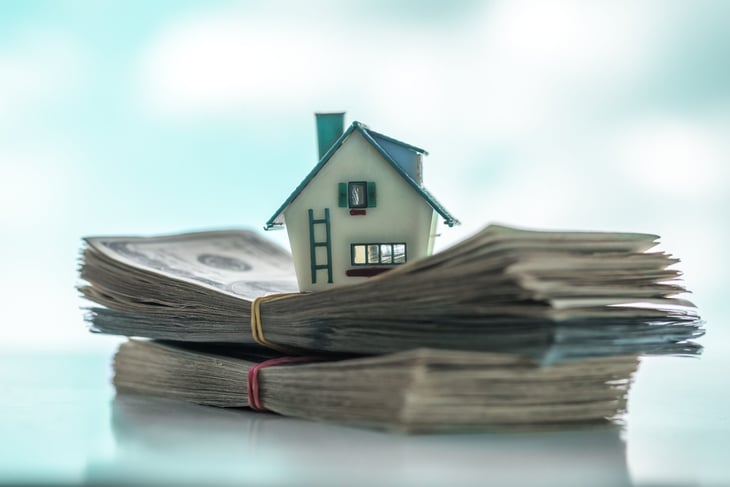
Editor's Note: This story originally appeared on Point2.
This end of the year brought the highest fixed mortgage rate in decades — and, with it, a tough question to answer: How much can we afford to spend on a home anymore?
For those playing the waiting game and hoping for a better housing market on the horizon, a daunting realization has set in: Last year’s income would have bought more for less.
As prices stray further from what qualifies as someone’s “within budget,” buying power is diminishing for aspiring homeowners who find home prices — and sizes — far exceeding their income.
And, nowhere is this combined freefall of affordability and space more deeply felt than in some of the nation’s 100 largest cities.
Uphill Battles for Homebuyers

- Compared with 2022, the average 2023 home seeker in the U.S. could afford to spend about $3,100 less on a home. Although not encouraging, it’s a drop in the ocean compared to the year-over-year $96,800 loss in buying power that they experienced.
- With the average size of a bedroom in the U.S. around 132 square feet, some of these drops in space represent the equivalent of 1, 2, or almost 3 bedrooms.
The uphill battle with mortgage rates was experienced across the nation.
Fixed mortgage rates climbed from around 3% at the end of 2021 to 7% at the end of 2022 to about 7.5% as of November 2023 — the highest levels in 20 years.
2022’s dramatic uptick prompted Point2 to analyze its impact on affordability and the average living space that comes with it, with equally dramatic results.
While yearly changes this time around are not as harsh, things were far from ideal for the median-income homebuyer in 2023 — a year defined by drastic measures to fight inflation.
30-Year Fixed-Rate Mortgage Average in the U.S.

Back in 2022, the average American with a $74,800 median income was able to afford a $278,200 home.
That’s assuming a standard 20% down payment and a 30-year, fixed-rate mortgage (including insurance and taxes) that wouldn’t require more than 30% of their monthly income.
Although the median income in the United States increased to nearly $78,200 in 2023, the average homebuyer can now afford to spend even less on a home.
More precisely, aspiring homeowners would be able to buy a $275,000 property in 2023 — meaning exploding interest rates and dragging incomes that can’t keep up have lost potential homeowners more than $3,100 in buying power.
What’s worse, with the national median sale price at $412,000, this hypothetical $275,000 home that buyers could actually afford has become a unicorn in the U.S. housing market.
Mortgage Rates Surge, Cause Buying Power Shifts Among Country’s Largest Cities

Back in 2022, homebuyers in about half of the country’s 100 largest cities were crippled by losses of more than $100,000 in buying power compared with a year prior.
In 2023, the differences in affordable home prices were not as significant as they were in that post-pandemic period.
In fact, in a surprising balancing act, buyers in 50 of the 100 largest cities deal with drops in affordability, while those in the remaining 50 cities could now afford more.
However, the affordability crisis is highlighted by the fact that the median home price in the U.S. is now 50% higher than the affordable home price. What’s more, the share of homes that fall under this “affordable” category makes up less than 28% of the national for-sale inventory.
Notably, in many large urban centers, the median home price is twice what the average buyer can afford (assuming a 20% down payment and a 3%, 30-year, fixed-rate mortgage).
In light of mortgage rate hikes and increased prices, the very concept of affordability slips further and further away.
Big Cities Make Living Large Difficult

Buyers in 61 urban centers can afford less living space than in 2022. Averaging 2,164 square feet, homes in the U.S. are among the largest in the world.
But in a housing market plagued by skyrocketing home prices and mortgage rates, that’s little comfort for potential buyers operating on a simple correlation: The bigger the home, the bigger the price.
And, in a year defined by historical mortgage rate hikes, the reality was even bleaker as, on the contrary, a smaller home also commanded a big price.
Assuming a standard 20% down payment and a monthly mortgage payment (again, as part of a 30-year, fixed-rate mortgage and including insurance and taxes that don’t represent more than 30% of the household median income), our study defines an affordable home as a property that could be purchased by the average homebuyer without being financially burdened while on a median income.
Because the median income, home prices, and price per square foot vary from city to city, those who lost the most buying power did not necessarily experience the most significant losses in living space.
Methodology

Point2, a division of Yardi Systems Inc., covers real estate trends and news. Point2 studies are based on internal data, public records, governmental sources, online research, and other reliable third-party agencies.
- For this study, we took into consideration the 100 largest U.S. cities, according to the most recent population data from the U.S. Census Bureau.
- Based on the household median income in each city and assuming a standard 20% down payment; a monthly mortgage payment (including insurance and taxes) that doesn’t represent more than 30% of the median household income; and a 30-year, fixed-rate mortgage, we calculated how much house a median-income homebuyer could afford in 2022 and again in 2023, taking into consideration the 7% mortgage rate from 2022 and the 7.5% rate from November 2023. We then compared the two amounts to calculate how much buying power the average homebuyer lost year-over-year in the United States.
- Median household income sourced from the 2022 ACS 1-year estimates, adjusted for 2023 using the Employment Cost Index Wage and Salaries increase from September 2022 to September 2023.
- Based on price per square foot data from Redfin for 2022 and October 2023, we translated the affordable amounts into affordable square footage and number of bedrooms, comparing 2022 and 2023 results.
- The assessed value used for calculating the property tax may be subject to various exemptions, depending on local/zonal policies.
- Insurance costs may differ, depending on home value, home condition, and personal credit score.





Add a Comment
Our Policy: We welcome relevant and respectful comments in order to foster healthy and informative discussions. All other comments may be removed. Comments with links are automatically held for moderation.